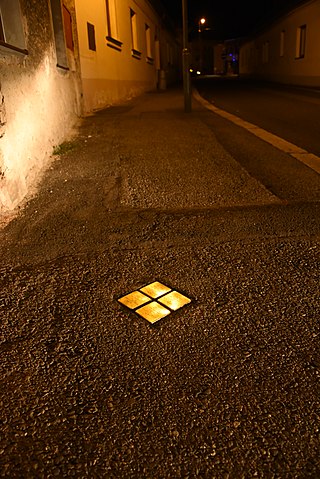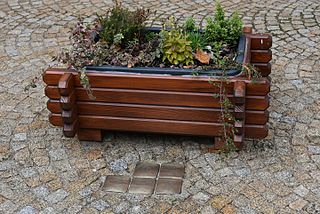
Josefov is a town quarter and the smallest cadastral area of Prague, Czech Republic, formerly the Jewish ghetto of the town. It is surrounded by the Old Town. The quarter is often represented by the flag of Prague's Jewish community, a yellow Magen David on a red field.

The history of the Jews in Prague, the capital of today's Czech Republic, relates to one of Europe's oldest recorded and most well-known Jewish communities, first mentioned by the Sephardi-Jewish traveller Ibrahim ibn Yaqub in 965 CE. Since then, the community has existed continuously, despite various pogroms and expulsions, the Holocaust, and subsequent antisemitic persecution by the Czech Communist regime in the 20th century.

The Old Jewish Cemetery is a Jewish cemetery in Prague, Czech Republic, which is one of the largest of its kind in Europe and one of the most important Jewish historical monuments in Prague. It served its purpose from the first half of the 15th century until 1786. Renowned personalities of the local Jewish community were buried here; among them rabbi Jehuda Liva ben Becalel – Maharal, businessman Mordecai Meisel (1528–1601), historian David Gans and rabbi David Oppenheim (1664–1736). Today the cemetery is administered by the Jewish Museum in Prague.

Frederika "Friedl" Dicker-Brandeis, was an Austrian artist and educator murdered by the Nazis in the Auschwitz-Birkenau extermination camp. From 1919-1923 she was involved at the Weimar Bauhaus in textile design, printmaking, bookbinding, and typography workshops.

Maisel Synagogue is one of the historical monuments of the former Prague Jewish quarter. It was built at the end of the 16th century which is considered to be the golden age of the ghetto. Since then its appearance has changed several times, its actual style is neo-gothic. Nowadays the synagogue belongs to the Jewish Community of Prague and is administered by the Jewish Museum in Prague as a part of its expositions.

I Never Saw Another Butterfly: Children's Drawings and Poems from Terezin Concentration Camp, 1942–1944 is a collection of works of art and poetry by Jewish children who lived in the concentration camp Theresienstadt. They were created at the camp in secret art classes taught by Austrian artist and educator Friedl Dicker-Brandeis. The book takes its title from a poem by Pavel Friedmann, a young man born in 1921 who was incarcerated at Theresienstadt and was later killed at Auschwitz. The works were compiled after World War II by Czech art historian Hana Volavková, the only curator of the Jewish Museum in Prague to survive the Holocaust. Where known, the fate of each young author is listed. Most died prior to the camp being liberated. The original Czech edition was published in 1959 for the State Jewish Museum in Prague; the first English edition was published in 1964 by the McGraw-Hill Book Company.

The Spanish Synagogue is the newest synagogue in the area of the so-called Jewish Town; it was in fact built at the site of the presumably oldest synagogue, Old School. The synagogue is built in Moorish Revival Style. Only a little park with a modern statue of Franz Kafka lies between it and the Church of the Holy Spirit. Today, the Spanish Synagogue is administered by the Jewish Museum in Prague.

The Jewish Museum in Prague is a museum of Jewish heritage in the Czech Republic and one of the most visited museums in Prague. Its collection of Judaica is one of the largest in the world, about 40,000 objects, 100,000 books, and a copious archive of Czech Jewish community histories.

The Klausen Synagogue is nowadays the largest synagogue in the former Prague Jewish ghetto and the sole example of an early Baroque synagogue in the ghetto. Today the synagogue is administered by the Jewish Museum in Prague.

The Ceremonial hall of the Prague Jewish Burial Society was built for the last service to the deceased members of the Prague Jewish Community. It is used as an exhibition space administered by the Jewish Museum in Prague. The building is an excellent example of Romanesque Revival architecture.
Gustav Sicher was a chief rabbi of Prague.

The Stolpersteine in Prague-Josefov lists the Stolpersteine in the town quarter Josefov of Prague, the former Jewish quarter of the city. Stolpersteine is the German name for stumbling blocks collocated all over Europe by German artist Gunter Demnig. They remember the fate of the Nazi victims being murdered, deported, exiled or driven to suicide.

The Stolpersteine in the Plzeň Region lists the Stolpersteine in the Plzeň Region of the Czech Republic. Stolpersteine is the German name for stumbling blocks collocated all over Europe by German artist Gunter Demnig. They remember the fate of the Nazi victims being murdered, deported, exiled or driven to suicide.

The Stolpersteine in Lomnice u Tišnova lists the Stolpersteine in the town Lomnice in the South Moravian Region. Stolpersteine is the German name for stumbling blocks collocated all over Europe by German artist Gunter Demnig. They remember the fate of the Nazi victims being murdered, deported, exiled or driven to suicide.

The Stolpersteine in Mikulov, Slavkov u Brna and Znojmo lists the Stolpersteine in three towns of the South Moravian Region. Stolpersteine is the German name for stumbling blocks collocated all over Europe by German artist Gunter Demnig. They remember the fate of the Nazi victims being murdered, deported, exiled or driven to suicide.

The Stolpersteine in Prague-Žižkov lists the Stolpersteine in a cadastral district Žižkov of Prague. The district has been split off. Since 2002 it belongs mainly to Praha 3, but smaller parts belong to Praha 8 and Praha 10. The district is named after Hussite military leader Jan Žižka. Stolpersteine is the German name for stumbling blocks collocated all over Europe by German artist Gunter Demnig. They remember the fate of the Nazi victims being murdered, deported, exiled or driven to suicide.

Stolpersteine is the German name for stumbling blocks collocated all over Europe by German artist Gunter Demnig. They memorialize the fate of the victims of Nazi Germany being murdered, deported, exiled or driven to suicide. The Stolpersteine in Neratovice, a town in the Central Bohemian Region of the present-day Czech Republic, were collocated in 2010.

The Stolpersteine in Hranice na Moravě lists the Stolpersteine in the town Hranice na Moravě, Czech Republic. Stolpersteine is the German name for stumbling blocks collocated all over Europe by German artist Gunter Demnig. They remember the fate of the Nazi victims being murdered, deported, exiled or driven to suicide.

Tobias Jakobovits was a Rabbi, historian and Czech librarian, historian of Czech Jewry, and an expert in ancient Hebrew manuscripts. He was the chief librarian of the Prague Jewish community in the inter-war period, and the professional manager of the Jewish Museum in Prague during the Nazi Occupation. He was deported to the Auschwitz concentration camp in the fall of 1944 and was murdered there along with his wife.




















